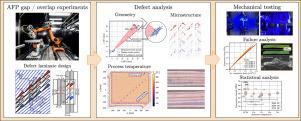几何诱导的三角形间隙和重叠缺陷对原位聚丙烯制造结构的影响
IF 7.1
2区 材料科学
Q1 MATERIALS SCIENCE, COMPOSITES
引用次数: 0
摘要
本文研究了复杂几何形状自动铺放纤维(AFP)导致的实际三角形间隙和重叠缺陷,以及它们对原位自动铺放纤维(AFP)制造的层压板的组成和力学性能的影响。使用原位AFP制造具有实际交错缺陷的层压板,并与热压重新巩固的参考层压板进行比较。微观分析显示,缺陷导致的孔隙度局限于缺陷边缘(缺口)或缺陷轮廓外(重叠部分),这可以通过随后的铺层方向显著减轻。尽管存在这些微观结构变化,但对拉伸和抗压强度和模量的影响很小,这表明交错缺陷对层压板成分的亚临界破坏。虽然在间隙缺陷和重叠缺陷之间观察到细微的差异,但制造配置对机械性能的影响更大,热压试样具有更高的强度和模量。这些发现提供了初步证据,表明原位AFP层压板可以容忍与几何相关的缺陷,而不会造成实质性的性能下降,为未来的工艺优化和缺陷容忍策略提供了信息。本文章由计算机程序翻译,如有差异,请以英文原文为准。

Effect of geometry-induced triangular gap and overlap defects on in-situ AFP-manufactured structures
This study investigates realistic triangular gap and overlap defects resulting from complex geometry Automated Fiber Placement (AFP) and their effect on laminate composition and mechanical properties of in-situ AFP-manufactured laminates. Laminates with realistically staggered defects are manufactured using in-situ AFP and compared to hot press re-consolidated reference laminates. Microanalysis reveals defect-induced porosity localized at defect edges (gaps) or outside the defect contour (overlaps), which can be significantly mitigated by subsequent ply orientation. Despite these microstructural variations, the impact on tensile and compressive strength and modulus is minimal, suggesting a sub-critical disruption of the laminate composition from staggered defects. While subtle differences are observed between gap and overlap defects, a larger influence of mechanical performance is given by the manufacturing configuration, with hot pressed specimens exhibiting higher strength and modulus. These findings provide initial evidence suggesting that geometry-related defects can be tolerated in in-situ AFP laminates without substantial performance degradation, informing future process optimization and defect tolerance strategies.
求助全文
通过发布文献求助,成功后即可免费获取论文全文。
去求助
来源期刊

Composite Structures
工程技术-材料科学:复合
CiteScore
12.00
自引率
12.70%
发文量
1246
审稿时长
78 days
期刊介绍:
The past few decades have seen outstanding advances in the use of composite materials in structural applications. There can be little doubt that, within engineering circles, composites have revolutionised traditional design concepts and made possible an unparalleled range of new and exciting possibilities as viable materials for construction. Composite Structures, an International Journal, disseminates knowledge between users, manufacturers, designers and researchers involved in structures or structural components manufactured using composite materials.
The journal publishes papers which contribute to knowledge in the use of composite materials in engineering structures. Papers deal with design, research and development studies, experimental investigations, theoretical analysis and fabrication techniques relevant to the application of composites in load-bearing components for assemblies, ranging from individual components such as plates and shells to complete composite structures.
 求助内容:
求助内容: 应助结果提醒方式:
应助结果提醒方式:


